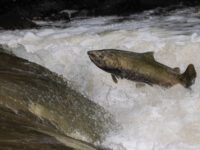“Over the past several weeks,” said District Manager of the Sonoma Agricultural Commission Stefan Parnay, last week, “there have been so many new finds it’s hard to keep track of them.”
In Sonoma County there have been 20, all together, since August, and in the Carneros region, where there have been over a dozen found, the existing quarantine is about to be extended and new measures applied. The question on many growers’ minds is: How long will that quarantine last, how far will it be expanded and will there be others? The question on some residents’ minds is: will the additional measures be safe?
Dr. James R. Carey, professor and former vice chair, Department of Entomology, U.C. Davis said many of his colleagues say this is just another leaf-rolling pest, “so what’s the big deal here?”
USDA spokesman Larry Hawkins, in response to the question, said the “big deal” is the emergency status, and the requirement for quarantine is defined by the existence of the LBAM. “As long as it’s a quarantine pest,” he said in a recent interview, “then we are by law required to do something with it.” As to what determines the LBAM to be a “quarantine pest” the answer is somewhat circular. “It’s a pest not known in the U.S. It’s a quarantine pest in other countries with which we trade.”
Santa Cruz nursery manager Teresa Aquino – who closed her small nursery after an LBAM had been confirmed, rather than spray with an organophosphate as directed by the CDFA – agrees with Dr. Carey’s view. She said recently, when asked about damage in the Santa Cruz area, that, to her, there is still no evidence, despite continuing infestation. She said she thought the emergency concept and the CDFA’s science about the insect was flawed, citing two examples. “CDFA says there are no native predators. Does it take a DNA test to determine a non-native? Spiders, earwigs, wasps all eat them.”
Nancy Gillette, Ph.D., a Forest Service research entomologist at the Pacific Southwest Research Station, in a recent interview said Aquino was partially correct. “Parasitic insects, wasps, tend to be species specific, so [the LBAM] may not have parasites that will attack it, [but] it most certainly would be subject to predation by a complex of fly larvae or adult beetles that prey on insects that are exposed.” However, she added, these would probably not provide sufficient control.
As to how actually damaging the insect is, two views apply: one, that, being “polyphagous,” it will munch its way through California laying waste acres of varied farm crops, and two: that the term “polyphagous” simply means it has a varied diet. Gillette, putting both views in perspective, said, “[An insect] can be polyphagous and absolutely voracious with a particular host plant. It doesn’t necessarily mean it will be a severe pest, but it’s a possibility.” She gave a familiar example of the Gypsy Moth (Lymantria dispar), introduced to America from Europe in the 1860s, which proliferated and caused severe defoliation and sometimes mortality of native hardwoods. “It has a wide host range, but it prefers oaks, and is especially damaging to them.” The Gypsy Moth, she explained, is now contained – not eradicated – by annual pheromone-based mating disruption program – similar to what is being prescribed for LBAM. “Literally tens of thousands of acres are treated every year,” said Gillette, “and it’s demonstrated to be effective.”
Twist ties – pheromone-laced objects designed to disrupt the mating cycle – are now being planned for the area under quarantine, said Hawkins, but first, the USDA must go through a process of approvals and studies in consultation with the U.S. Fish and Wildlife Commission. “Because in the southern part of Sonoma County there are some threatened and endangered species,” he said, “and we have to make sure the placement is not going to make a problem.” Some of the problems they hope to avoid have nothing to do with the twist ties themselves. “Some of those areas are fairly remote,” he said. “They just don’t want people tramping around in there.” The environmental clearances should take 30 days or so, and people may see them being applied around the early part of February, he said. “But that’s not firm.”
Meanwhile, the imposition of quarantine is hard on everyone. Sonoma County Agricultural Commissioner Lisa Correa, said, after the most recent find, “We’re trapping year round,” adding, “I’m concerned.” CDFA spokesman Jay Van Rein said his concern is that the latest quarantine will extend into spring and fall. “Over the long term,” he said, “we’ll have to work with growers in the area to make sure we can find ways for their crop to be harvested and move safely.”
Sonoma grower Ned Hill said, “It’s sort of a quandary for us. For our own crops, I’m not worried – except if they find [the moth], I can’t ship my grapes. But for California agriculture, as a whole, I can’t say.” Nevertheless, he’s taking no chances on harboring the LBAM. “We’re spraying to make sure the people checking our fields won’t find them.”
The question remains: If there is no locally evident damage, no legally recognized emergency, why all the trouble? John Connell, director of plant health and pest prevention services of the CDFA, told the Sonoma County Board of Supervisors in July, “Other countries besides the U.S. have quarantines against the LBAM. The idea that California or the USDA can declare the apple moth not a significant pest is inaccurate. Our trading partners around the world are responsible and have the ability to declare what is a significant pest and what they want to keep out of their environments as well. And so the status of LBAM in the global perspective is one of a significant pest.”
However, Daniel Harder, director of the UCSC Arboretum and adjunct professor in the Department of Ecology and Evolutionary Biology at U.C. Santa Cruz, stated in a report often cited by eradication opponents, that following an extensive research trip to New Zealand, where the LBAM is endemic, he determined that the eradication of the introduced pest may not be possible and is probably unnecessary.
Harder said the primary damage in New Zealand occurred prior to 2001, when agricultural authorities used organophosphate pesticides in order to comply with USDA requirements that no trace of LBAM be found. He explained that these pesticides eliminated all the LBAM’s predators but once the pesticide applications were stopped, the natural predators returned, and the LBAM population dwindled to its present “insignificant” level.
“In the Nelson area, roughly four to 10 percent of producers are organic. Because organic systems encourage beneficial insect populations and do not negatively affect beneficial organisms and insects with the use of harsh chemical controls, pests (including LBAM) are not significant problems for localized organic producers.”
However, Gillette said, other recent studies continue to call the LBAM “one of the most important pests of tree fruits in Australia and New Zealand” but indicate that pheromone-mediated mating disruption continues to be a “major tool of sustainable Integrated Pest Management (IPM) in horticulture.”
Light Brown Apple Moth scourge or simple pest?
More from What's HappeningMore posts in What's Happening »
- Cartoon by Hillary: “Finally We Do Thanksgiving…My Way”
- Permit Sonoma Recommends Decertification of the SDC Specific Plan Environmental Report and Abandoning the SDC Specific Plan
- Chinook Salmon Spotted in Valley Creeks
- Lighted Tractor Parade Set for November 30 on Sonoma Plaza
- Creative Sonoma Announces #TeachTheArts Campaign to Boost Local Teaching Workforce
- The Living Legacy of Mac McQuown






